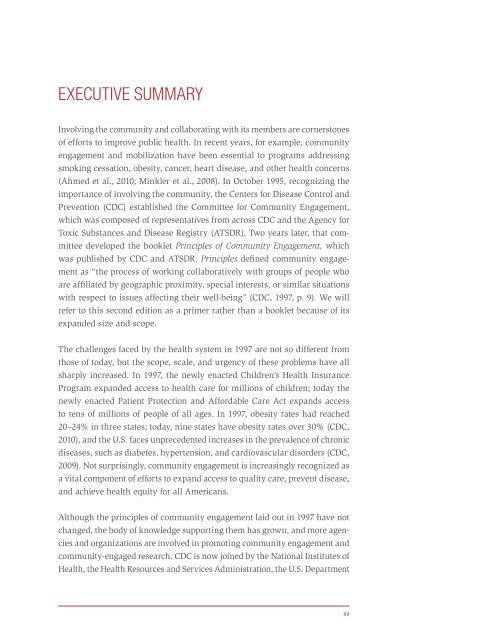Principles of Community Engagement (Second Edition)
Principles of Community Engagement (Second Edition)
Principles of Community Engagement (Second Edition)
You also want an ePaper? Increase the reach of your titles
YUMPU automatically turns print PDFs into web optimized ePapers that Google loves.
EXECUTIVE SUMMARY<br />
Involving the community and collaborating with its members are cornerstones<br />
<strong>of</strong> efforts to improve public health In recent years, for example, community<br />
engagement and mobilization have been essential to programs addressing<br />
smoking cessation, obesity, cancer, heart disease, and other health concerns<br />
(Ahmed et al , 2010; Minkler et al , 2008) In October 1995, recognizing the<br />
importance <strong>of</strong> involving the community, the Centers for Disease Control and<br />
Prevention (CDC) established the Committee for <strong>Community</strong> <strong>Engagement</strong>,<br />
which was composed <strong>of</strong> representatives from across CDC and the Agency for<br />
Toxic Substances and Disease Registry (ATSDR) Two years later, that committee<br />
developed the booklet <strong>Principles</strong> <strong>of</strong> <strong>Community</strong> <strong>Engagement</strong>, which<br />
was published by CDC and ATSDR <strong>Principles</strong> defined community engagement<br />
as “the process <strong>of</strong> working collaboratively with groups <strong>of</strong> people who<br />
are affiliated by geographic proximity, special interests, or similar situations<br />
with respect to issues affecting their well-being” (CDC, 1997, p 9) We will<br />
refer to this second edition as a primer rather than a booklet because <strong>of</strong> its<br />
expanded size and scope<br />
The challenges faced by the health system in 1997 are not so different from<br />
those <strong>of</strong> today, but the scope, scale, and urgency <strong>of</strong> these problems have all<br />
sharply increased In 1997, the newly enacted Children’s Health Insurance<br />
Program expanded access to health care for millions <strong>of</strong> children; today the<br />
newly enacted Patient Protection and Affordable Care Act expands access<br />
to tens <strong>of</strong> millions <strong>of</strong> people <strong>of</strong> all ages In 1997, obesity rates had reached<br />
20–24% in three states; today, nine states have obesity rates over 30% (CDC,<br />
2010), and the U S faces unprecedented increases in the prevalence <strong>of</strong> chronic<br />
diseases, such as diabetes, hypertension, and cardiovascular disorders (CDC,<br />
2009) Not surprisingly, community engagement is increasingly recognized as<br />
a vital component <strong>of</strong> efforts to expand access to quality care, prevent disease,<br />
and achieve health equity for all Americans<br />
Although the principles <strong>of</strong> community engagement laid out in 1997 have not<br />
changed, the body <strong>of</strong> knowledge supporting them has grown, and more agencies<br />
and organizations are involved in promoting community engagement and<br />
community-engaged research CDC is now joined by the National Institutes <strong>of</strong><br />
Health, the Health Resources and Services Administration, the U S Department<br />
xv

















